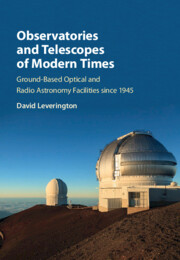 Observatories and Telescopes of Modern Times
Observatories and Telescopes of Modern Times from Part 1 - Optical Observatories
Published online by Cambridge University Press: 15 December 2016
La Silla
European Southern Observatory's Early Telescopes
After the Second World War the most immediate priority in western Europe was to feed and house its people aided by the American Marshall Plan. Once that problem had largely been solved these western European countries began to consider how to ensure that such a European conflict could not happen again. One way of doing this was to work together in joint ventures. On the scientific side the first such initiative was in the field of nuclear physics which eventually resulted in the establishment of CERN in 1953.(1)
In the same year Walter Baade of the Mount Wilson and Palomar Observatories had been invited by Jan Oort to spend two months at the Leiden Observatory. During his visit Baade suggested that it would be a good idea if European astronomers considered establishing a joint European observatory. At that time the largest optical telescopes were in the northern hemisphere so it would be best if the suggested new observatory were built in southerly latitudes. A southern observatory would also be beneficial as the Magellanic Clouds and the central region of the Milky Way were best observed from well south of the equator. Baade suggested that the observatory's main instruments should be a 120 inch (3 m) reflector similar to that of the Lick Observatory and a 48 inch (1.2 m) Schmidt like that on Mount Palomar (see Section 1.2).(2) Using these existing designs as a basis should enable the European versions to be built more quickly and cheaply than if the telescopes had to be designed from scratch. Baade's idea was discussed shortly afterwards by a group of European astronomers who had gathered at Groningen, in the Netherlands, in June 1953 for a conference on galactic research. The meeting concluded that a meridian circle should be added to Baade's proposed instrument complement to undertake much-needed astrometric work in the southern hemisphere.
At the time South Africa was the envisaged location of the observatory in view of its known good observational conditions and the fact that a number of European countries already owned or used observational facilities there.
To save this book to your Kindle, first ensure [email protected] is added to your Approved Personal Document E-mail List under your Personal Document Settings on the Manage Your Content and Devices page of your Amazon account. Then enter the ‘name’ part of your Kindle email address below. Find out more about saving to your Kindle.
Note you can select to save to either the @free.kindle.com or @kindle.com variations. ‘@free.kindle.com’ emails are free but can only be saved to your device when it is connected to wi-fi. ‘@kindle.com’ emails can be delivered even when you are not connected to wi-fi, but note that service fees apply.
Find out more about the Kindle Personal Document Service.
To save content items to your account, please confirm that you agree to abide by our usage policies. If this is the first time you use this feature, you will be asked to authorise Cambridge Core to connect with your account. Find out more about saving content to Dropbox.
To save content items to your account, please confirm that you agree to abide by our usage policies. If this is the first time you use this feature, you will be asked to authorise Cambridge Core to connect with your account. Find out more about saving content to Google Drive.